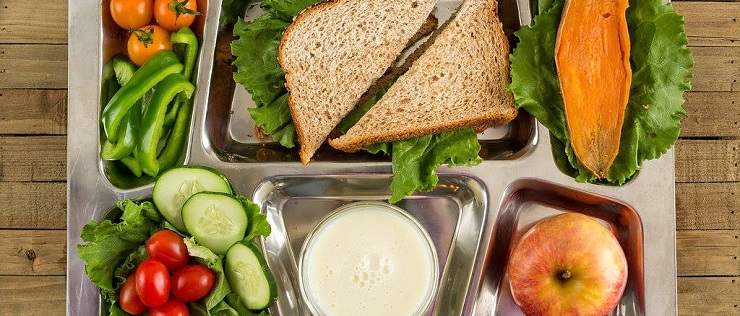When was the last time you had a school lunch?
If you answered, “When I was in school, ” then it’s time for you to make a lunchtime visit to your child’s cafeteria. You’ll be surprised how much has changed!
Today’s school cafeterias provide much more variety and nutrition than lunchrooms of old. Here are just a few examples of what today’s school nutrition programs offer:
- Salad, soup, potato, pizza and deli bars
- Ethnic menus featuring Mexican, Italian, Greek and Chinese favorites
- “Scramble system,” similar to the food courts you find at the local mall
- “Offer vs. serve” plans where students may select from several choices in each food group
And today’s school cafeterias are much more fun to eat in, too! Many new and renovated school cafeterias are featuring:
- Small square or round tables and even booths instead of long, bench-style seating
- Brightly colored walls, often with murals
- Neon lights
- Snappy, “fast-food” menu displays rather than construction paper signs
Tasty and Nutritious
Today’s kids are much more sophisticated than we were at their age, even in terms of the food they like. And with school lunch, if they don’t like what they see, they won’t eat it. But don’t think for a minute that school nutrition programs have sacrificed nutrition for taste just to keep kids interested! Schools participating in the National School Lunch Program are required to plan menus that meet at least one-third of a child’s Recommended Dietary Allowance (RDA). Plus, school nutrition managers across the country are:
- Implementing the principles outlined in the Dietary Guidelines for Americans.
- Revamping children’s old, favorite recipes with ingredients lower in salt, sugar, fat and cholesterol and higher in fiber.
- Introducing more fresh fruits and vegetables and whole grains to students.
Because of their knowledge of child nutrition, school nutrition managers know that growing children need more calories than adults. They plan meals high in carbohydrates to be sure they keep calories high while cutting fat and sugar. Remember this the next time you’re concerned about the calories in your child’s school lunch. Also, when you read your child’s school lunch menu, remember, what seems like high-fat food may not be. Take hamburgers and french fries, for example. The ground beef is probably leaner than what you buy in the supermarket and the french fries are more than likely baked instead of fried.
Education is Key
As you know, getting children to eat foods that are good for them is often a difficult task. But many school nutrition managers work with teachers, principals and school health professionals to educate students about good nutrition through:
- Classroom demonstrations
- Cafeteria programs such as special athletic “Training Tables”
- Special promotional and marketing campaigns such as the American School Food Service Association’s “Shape Your Future” campaign.
Competitive Foods
Although federal guidelines prohibit the sale of carbonated beverages, some candy and certain other snacks in the food service area during lunch, many students are still able to obtain these items and often eat them instead of school lunch. Banks of vending machines line many school corridors, and snack bars often operate in direct competition with the school lunch. With strong community support, some school nutrition programs have been successful in taking over school vending machines and stocking them with school-made items, 100 percent fruit juice and other nutritious foods.
What a Bargain
Schools participating in the National School Lunch Program receive federal, state and sometimes local funds for each student meal they serve. This reimbursement makes up the difference between what the lunch costs to produce and what the student pays. Although the amount of federal reimbursement paid per lunch depends on the economic need of the student, reimbursement keeps the cost of lunch low for all students.
Many schools also receive a variety of commodity foods such as lean ground beef, chicken, ground turkey and turkey roasts, grain and other products from the U.S. Department of Agriculture. Often, these commodity foods are of higher quality than what you buy in retail grocery stores.
Thanks to this federal, state and local partnership, school food service programs offer a variety of well-balanced, nutritious meals at a cost much lower than a lunch of equal nutritional value brought from home or bought in a restaurant. That makes school lunch one of the best deals around!
Making Children Ready to Learn
Educators know it’s true: Poorly nourished children have poor attendance, have short attention spans and lack energy. In short, children suffering from poor nutrition have difficulty learning.
By providing good-tasting, nutritious meals in pleasant surroundings and helping to teach students the value of good nutrition, your child’s school nutrition program is an essential part of the education system.
You can play an active role in your child’s school nutrition program. Child nutrition professionals love to get parents and children involved in planning and marketing school meals, in nutrition education and in improving school environments that promote healthful eating habits. If you are interested in finding out more about your child’s school nutrition program, contact the school principal or the school nutrition manager.
